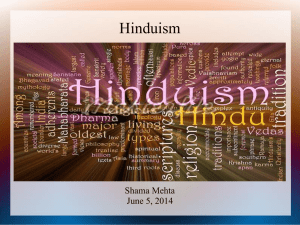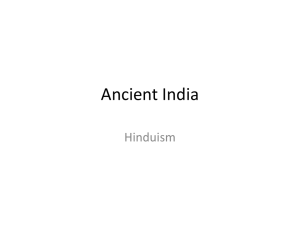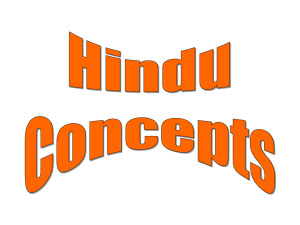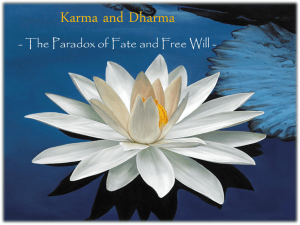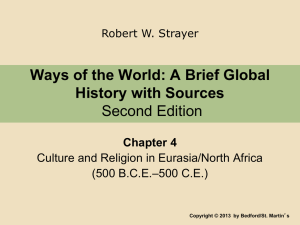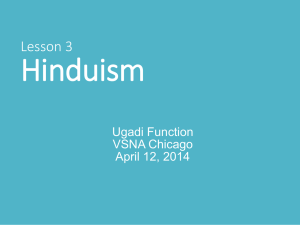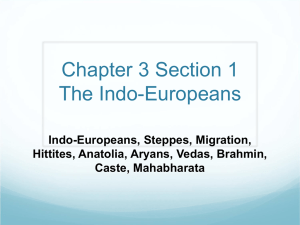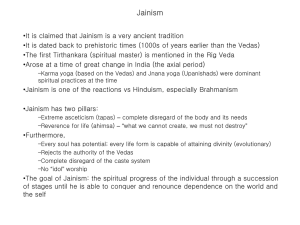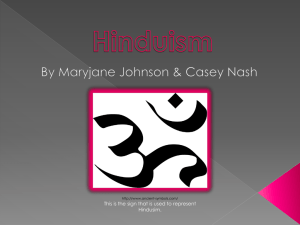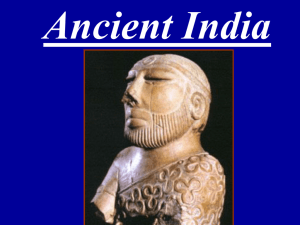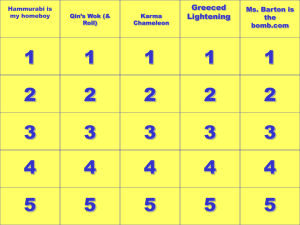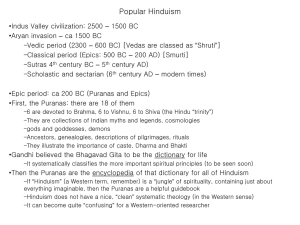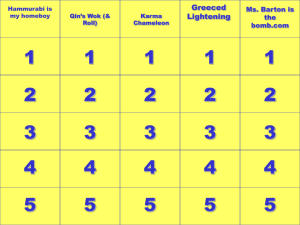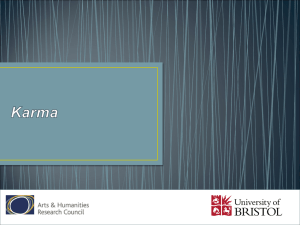Hinduism 1st - WordPress.com
advertisement
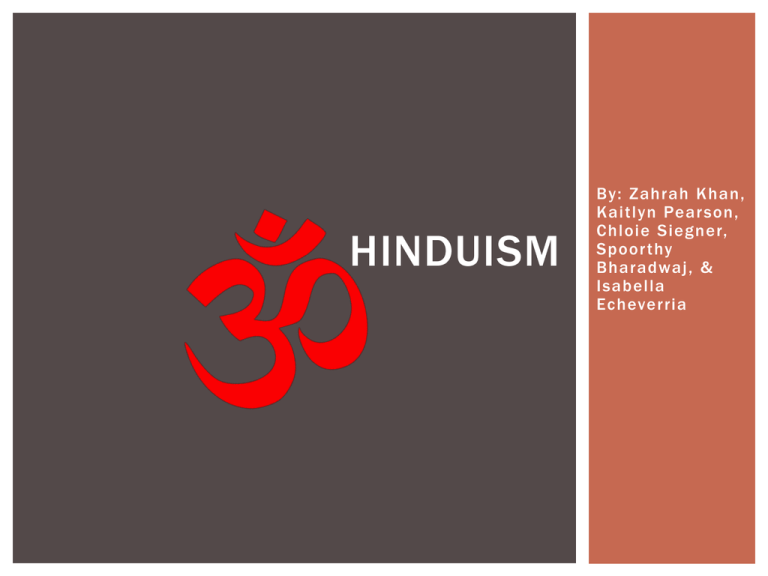
HINDUISM By: Zahrah Khan, Kaitlyn Pear son, Chloie Siegner, Spoor thy Bharadwaj, & Isabella Echeverria TRANSFORMATION OF HINDUISM & ITS INFLUENCE Hinduism does not originate from one single founder, a single book, or a single point in time. It contains many different beliefs, philosophies, and viewpoints. The Vedic religion comes from the ancient religion of the Aryan peoples who entered northwestern India from Persia circa 2,000-1,200 B.C. The Sanskrit language and the Vedic religion are the foundation to Hinduism and are attributable to the Aryans and their descendants. TRANSFORMATION OF HINDUISM & ITS INFLUENCE (CONT.) The first Hindu teachers were called Brahmins. They passed down teachings of Hinduism through oral stories at first. Later, the stories became Rig -Veda, which was written down in 1500 B.C. These teachings may have come from people called the Aryans whose language may have been the predecessor of Sanskrit. The lack of unifying overall religious authority and the total absence of a book claiming supreme truth have contributed to the diversity of Hinduism. MAIN GODS Most Hindus have a personal god or goddess such as Shiva, Krishna or Lakshmi that they pray to regularly. Brahma: known as the Creator Shiva: God of self-control and meditation Krishna: God of culture and knowledge Lakshmi: God of wealth and beauty POLY THEISM Polytheism is the worship of more than one god. In classical civilizations, Polytheism was popular in ancient Greece, the Republic of Rome, India and ancient Egypt. Zoroastrianism was the first monotheistic religion then followed by Christianity. Soon after these religions began, the popularity of polytheism began to decrease. FORMS OF WORSHIP With Hindus, worship can include a wide variety of prayers and practices. However, there are ten extremely common forms of worship practiced in today’s modern religion: Puja – ritual worship, especially of the deity Arti – the greeting ceremony with lamps, etc. Bhajan or Kirtan – hymns and chants (often during Arti) Darhsan – taking audience of a deity or holy person Parsad – offering and eating sacred food Pravachan – talk or lecture on the scriptures Havan – sacred fire ceremony Japa/Meditation/Prayer – internal practices of worship Parikrama/Pradakshina – circumambulation Seva – active service to the deity, holy people, etc. HOW GOD IS APPROACHED The relationship between man and God is purely personal so there is no set way of approaching. However, it is most common and expected to remove ones shoes before entering a temple. This ritual is strongly enforced outside in public temples, and people follow this at home as well. FORMS OF DISCIPLINE Satya (Truth) Ahimsa (Non-violence) Brahmacharya (Celibacy, non-adultery) Asteya (No desire to possess or steal) Aparighara (Non- corrupt) Shaucha – (Cleanliness) Santosh (Contentment) Swadhyaya (Reading of scriptures) Tapas (Austerity, perseverance, penance) Ishwarprandihan (Regular prayers) KARMA The sum of a person’s actions in this and previous states of existence, are viewed in deciding their fate in future existences. A Sanskrit term meaning “actions” or “deeds”. Karma is a concept common to Hinduism, Buddhism, and Jainism, yet is interpreted in many dif ferent ways. Karma is a broad principle of life based on a system of cause and ef fect, action and reaction. In Hinduism, karma is used as an explanation for evil and misfortune in the world. If you appear to not derive your misfortune, it is assumed that you had done some wrong action in a previous life. Karma is primarily tied to “bad karma” which blinds a person’s soul or “good karma” that can wipe out the bad. KARMA (CONT.) 3 Types of Karma: Prarabdha – Karma experienced during present life Sancita – The store of karma that has not yet reached fruition Agamin or Sanciyama – karma shown in present life foreshadowing future karma: answers, why is there suffering? REINCARNATION Reincarnation, “passage from one body to another”, “to begin again”, involves the rebirth of the soul in a series of embodiments. The embodiments are most commonly human or animal but can also be divine. The process of ones reincarnation is dependent on their karma. “Just as a man discards worn out clothes and puts on new clothes, the soul discards worn out bodies and wears new ones.” (2.22) Answers the question, “What happens after death? Before birth?” MOKSHA Moksha is the ultimate goal of life. Moksha means release from samsara. It is only achieved through union with God. Union with God is understood in dif ferent ways: Complete union of identity Unity of purpose The soul is compared to a drop of water and liberation to its merging into the ocean represents the Supreme Soul (God) Answers the question, “What is the goal in life?” DHARMA Dharma is the duties that sustain us according to ur intrinsic nature. It is to sustain us. It is what we are meant to do. Answers the question, “What is the right way to act?” Two main types: Sanatana-Dharma: duties which take into account one’s spiritual identity Vamasharma-Dharma: Duties performed according to one’ s material nature. Basic moral codes are called sadharana. KEY POINT OF HINDUISM Hinduism is diverse Begins simply by dif ferentiating between matter and spirit. Spirit is understood within two main categories: Individual self or soul Supreme Self or God The Atman is the soul. It answers, who are we? What is the real self? The three truths ROLE OF WOMEN IN THE RELIGON Women often studied sacred traditions or lore and were also known for producing hymns. Women were allowed to own property and often get married in their teens to establish strong discipline to their husbands. Married women could participate in more rituals but were rather limited in comparison to the male. HOW THE CASTE SYSTEM TIES IN WITH RELIGION Religious practices are tied in very strongly with the caste system. Brahmans were often orthodox to the point where it was and still is an obsession. There are several sub categories Brahmins These sub categories have dif ferent gods they worship, and gods they exclude, can sometimes be prejudiced against certain gods. Even if both the groom and bride are Brahmins, parents often look for the exact “pedigree” of Brahmins. GREAT SCRIPTURES The Mahabharata is known for being the longest epic in world literature. Bharata was an early ancestor of both the Pandavas and Kauravas who fight each other in a great war. The conflict is over succession to the throne of Hatinapura, a kingdom north of modern Delhi that was most commonly known as the Bharatas. The work is divided into 18 books (concering an 18-day war among 18 armies). The Bhagavad Gita is a part of Mahabharata. It means the Song of the Bhagavan. Also known as the Gita, it is set in a dialogue between Pandava prince Arjuna and his guide godking Krishna. They are facing the duty of killing his relative and with the assistance of Krishna, is advised to “fulfill his Kshatryia (warrior) duty as a warrior and kill.” BIBLIOGRAPHY •http://www.ancient.eu/hinduism/ •http://www.britannica.com/EBchecked/topic/26631 2/Hinduism •http://edhelper.com/ReadingComprehension_42_42.html - http://www.religionfacts.com/hinduism/beliefs/karma.htm - http://www.hinduwebsite.com/reincarnation.asp - http://www.spiritual -wholeness.org/faqs/reincgen/hindrein.htm - http://hinduism.iskcon.org/concepts/106.htm - http://hinduism.iskcon.org/concepts/108.htm - http://hinduism.iskcon.org/concepts/100.htm -http://www.polytheism.net/ -http://www.sanatansociety.org/hindu_gods_and_goddesses/shiva.htm -http://www.koausa.org/Gods/God6.html

